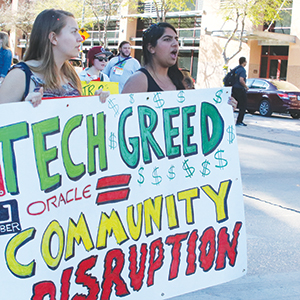Affordability crisis
Celebrity chefs and food show segments are common in Austin. While it’s still famous for its barbecue joints, one of its top culinary destinations is the acclaimed sushi restaurant Uchi, and newcomer Qui offers a $55 seven-course vegetarian tasting menu that would cost at least double that in the Bay Area.
The city that coined the much copied “Keep Austin Weird” mantra is becoming more stylish and less quirky. The glitzy Houston-based Hotel Zaza group will open a 24-story luxury hotel downtown next year. Mayor Adler even tried to spin the anti-gentrification rallying cry with a more corporate-safe interpretation. “‘Keep Austin Weird” means ‘Keep Austin Creative’,” Adler told his fellow mayors.
Red Wassenich, who coined the “Keep Austin Weird” phrase and printed up the first bumper stickers never intended it that way. “It was a small attempt to counter Austin’s descent into rampant commercialism and over-development,” he told an interviewer.
Housing affordability, once Austin’s killer app, is forcing out the musicians and artists who gave the city its distinct personality, as prices for downtown bungalows shoot into the high six figures. A historic Latino neighborhood and community businesses were displaced to make way for the newly-opened JW Marriott and Kimpton-operated Hotel Van Zandt.
“Oh well, kids weren’t very New Urban anyway,” a columnist remarked when Escuelita del Alma was relocated. Few SXSW conference-goers this month noticed a small but loud group of marchers carrying signs and demanding prosperity “not just for the white and wealthy.”
A pedicab operator told me he moved to Austin five years ago and rented a two-bedroom apartment for $599 a month. Now he’s paying $1,200 for a one-bedroom with the $20 fares he collects pedaling around the downtown.
Austin locals reminisce about the old days of Austin, which was known for “the wave”—a gesture of appreciation when a driver yielded a road courtesy. Now motorists are just as likely to receive a horn blast or one-fingered salute.
Austinites talk about the “douchebags” from New York and California who’ve moved to town. Two members of the food service industry laughed about a bartender who deliberately ignored a patron who started waving bills to try and attract service.
Austin now ranks first among the largest metros for new residents as a percent of total population. California contributed the most new residents.
Mayor Adler hopes to build 100,000 new housing units by 2025, which will make Austin one of the nation’s 10 largest cities.
We saw this coming
Silicon Valley’s wake-up call came in 1988 when the computer chip consortium Sematech chose Austin over San Jose for a manufacturing and development center, despite California Gov. George Deukmejian’s $125 million offer. San Jose Mayor Tom McEnery declared at the time that the valley was “in danger of losing our leadership position with the high technology industries.”
A blue ribbon task force of the valley’s government and industry leaders got down to business in 1992 with a flurry of meetings, reports and media announcements. Declaring “the Silicon Valley economy is at risk,” they set out to improve the valley’s transportation systems, expand its housing stock and launch workforce training programs, along with branded schemes like the “21st Century Education Initiative.” While California offered subsidies and a series of “Measure A” sales tax initiatives to widen roads and install light rail tracks, Texas offered no taxes, cheap rents, good music and cold beer.
Magically, Silicon Valley survived and prospered, but it had little to do with public-private initiatives of Joint Venture Silicon Valley or San Jose’s now-defunct Redevelopment Agency. The introduction of the Netscape browser in 1994 and the touchscreen smartphone in 2007 proved to be the transformative breakthroughs that no committee could have ever wrapped their agendas around.
Today, Silicon Valley’s biggest city is madly trying to catch up by artifying every traffic control box, empty doorway, crosswalk and empty wall it can attack with paintbrushes in a top-down beautification push to de-genericize the urban landscape.
San Jose Mayor Sam Liccardo joined mayors from Albuquerque, Sacramento, Baltimore and elsewhere at SXSW this month to discuss subjects such as reinventing civic IT infrastructures and the impacts of contract employment in the sharing economy.
As Liccardo left Austin’s new JW Marriott hotel, a 15-passenger pedal-powered party tram cruised by. Liccardo paused to admire the sidewalk art at 2nd and Brazos, an embedded art glass mosaic ribbon.
He commented on the “spellbinding collection of the brightest creative people here in Austin” for SXSW.
Then he stopped mid-sentence, and added with a sigh, “Half of them are from the Bay Area.”



